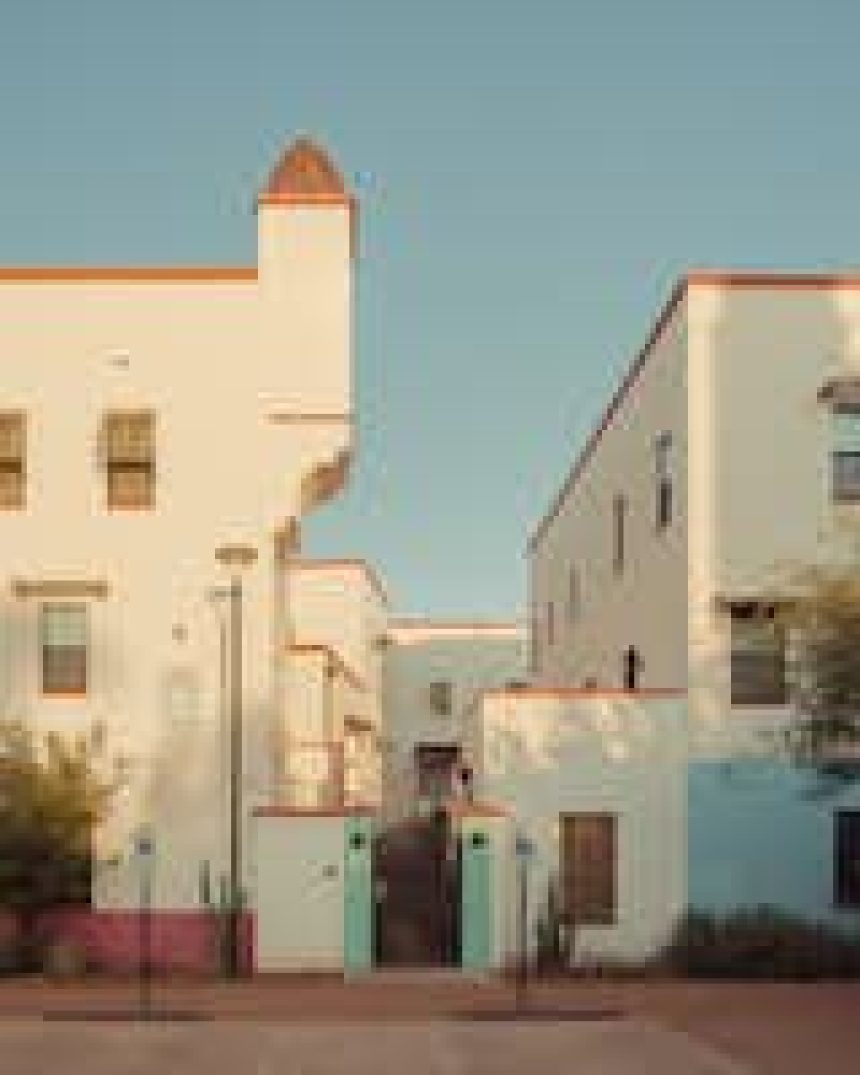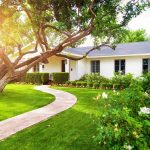It’s been two years since Culdesac Tempe, the self-proclaimed “first car-free neighborhood in America,” opened with a goal of making walkability its centerpiece. With the first phase finished last year, the high-profile development continues to unfold on a 17-acre site along a light rail line in an established neighborhood about 15 miles east of downtown Phoenix. The $200 million project now includes 288 apartment units with about 300 tenants, reeling residents in with appeals of a healthier, more eco-friendly lifestyle, built-in community with ample amenities, and accessible transit to Tempe and the greater metro area.
Along with the hype, the ambitious experiment—building a “car-free” neighborhood in one of the most auto-dependent population centers on the planet—has aroused skepticism. An article by the nonprofit advocacy organization Strong Towns, for instance, contends that Culdesac is a far cry from “the incremental urbanism and thickening our cities need. A dozen or even a thousand Culdesacs can’t solve that problem,” because they would lack long-term growth benefits including “the resilience of a system where many hands have built the neighborhood and have a financial stake in it” and would reflect “a zoning and finance stream that favors industrial over incremental production.”
But these critics don’t live there. Those with more proximity see the place as a big plus.
“We were really interested in reducing our carbon footprint, especially since I’d been commuting from Canada,” says Sheryl Murdock, a 50-year-old postdoctoral ocean researcher at Arizona State University who is well aware of the irony of where she conducts her particular work. To resolve this commuting dilemma, Murdock moved from British Columbia, where her husband and two children still live, into a one-bedroom apartment at the new development in June. “Culdesac said, ‘Here’s a free e-bike; here are free transit passes—use them.’ I was impressed, and the price is very reasonable for what you get.”
Studios start at around $1,300 per month and three-bedroom units around $2,700, an average-to-slightly high rental fee for the market, and many lessees were incentivized by perks like the ones Murdock describes. (The median rent for a studio in Tempe is $1,375, while three-beds go for $2,341, according to Apartments.com.)
Murdock was also struck by the distinctive sense of place, the product of not only its desert-modern aesthetics but of building strategies that mitigate heat, promote wind flow and cross-ventilation, and encourage social interaction. Architect and urban planner Daniel Parolek, of Berkeley, California, firm Opticos Design, led the project’s architectural design and wrote that “not needing to accommodate spaces for car storage or circulation … opened up the opportunity to focus on creating people-oriented spaces.”
Instead of broad asphalt streets, a series of paseos between 10- and 15-feet wide stretch between clusters of flat-topped, irregularly situated two- and three-story buildings coated in heat-deflecting white stucco and sporadically adorned with vibrant murals. Walkways open onto brick courtyards and communal spaces ornamented with public art.
“It reminds me of Mykonos,” Murdock says, however surprising that might sound. “The walkways, which limit sun and heat exposure, wind between bright white buildings while color accents make the whole thing feel bright and welcoming.” Her single complaint is that, with three access points to the now eight residential pods, each of which have between 6 and 14 small buildings, the metal gates could be quieter upon shutting. A relatively simple fix, she thinks; management’s responsiveness to feedback on its online resident portal has been encouraging, she says.
But elsewhere online, and earlier in the project’s opening phase, more substantive complaints had begun surfacing, many focusing on a lack of amenities and incomplete construction. “The retail spaces didn’t have tenants right away and people were annoyed the pool hadn’t been built yet,” says Murdock. “It didn’t hit the ground running but now there is a lot.”
The pool has since been finished. There’s a two-story fitness center, a dog park, spaces for remote work, and neighborhood-wide indoor/outdoor 1GB WiFi. More than a dozen small retailers include a bike shop, Korean market, coffee shop comparable in price to Starbucks, and a James Beard–nominated Mexican restaurant with offerings like the $32 “Pollo con Mole.” And with free light rail and an on-site five-dollar-an-hour car-rental service, access to outside amenities is arguably more seamless than for car owners in suburban neighborhoods.
“I’m hopeful the retail will become even more developed over the next few years, and this will become the ideal ‘15-minute city’ experience, where I’m close to everything I need,” says Murdock. That hope does not seem unfounded given Culdesac’s intended interactive nature, with seasonal weekly open markets and public events where tenants can engage with each other, prospective new retailers, and the community at large.
After the prolonged summer heat finally subsided, “the markets that restarted again this fall were bringing people in to shop and wander around and residents could talk to prospective vendors, and then other conversations would emerge,” says Murdock. “Improving bike infrastructure with local municipalities, for example, became part of the discussion.”
In fact, it was a public event here that sealed the deal for Ignacio Delgadillo, a 35-year-old insurance business manager from West Phoenix and staunch bicycling advocate. After selling his home in the fast-growing suburb of Goodyear, Delgadillo moved into a two-bedroom unit with his wife and four-year-old son at Culdesac in July. “We were drawn to the idea when we first read about it five years ago,” he says. “My wife and I were totally car-dependent living in Goodyear, and thought, Oh that looks cool for people who work from home or have no kids.”
Avid mountain bikers, the couple started riding more to get around during the pandemic as they grew increasingly tired of constant vehicle and home maintenance costs. They also developed new concerns once they became parents. “In Goodyear, we actually lived on a real cul-de-sac, and just like it was when I was growing up, kids would play on the street and whenever cars would come, they’d yell ‘car’ and make way,” says Delgadillo. “But people drive fast and can be careless, so we never really felt totally comfortable having our son on a bike, even on our semi-closed off street.”
At their new digs, Delgadillo says that except for a small parking lot to accommodate retail visitors, there’s really no interface between cars and people. “A main walkway extends throughout the property, and our son can spend hours out there riding his bike and we don’t have to worry,” he says. “And, we actually know our neighbors. We’ve probably made more connections here in six months than when we lived in the suburbs for 15 years.”
That elusive sense of community is a precious commodity and a real draw for millennials and zoomers, like Aryash Dubey, a 22-year-old pursuing a master’s in computer science at ASU who moved into a single-bedroom unit here in April. “I liked the fresh take on housing here and I can take the metro to school in like five minutes max,” says Dubey. “And I was impressed by how friendly the place is. I’ve met plenty of people I probably would not otherwise encounter, including the guy who started the project.”
That guy was, in fact, the community’s very first resident, 40-year-old Ryan Johnson, who moved into a unit in May 2023. Johnson, who helped establish real estate tech company Opendoor in 2014, cofounded Culdesac as a property development and management startup in the San Francisco Bay Area in 2018 before returning to his hometown during the pandemic.
“I grew up in the Phoenix suburbs and that’s all I really knew until I attended the University of Arizona,” he says. Johnson had earned a Flinn scholarship to study economics, established a real estate portfolio on the side, and traveled to more than 60 countries and some of the most walkable cities in the world, including Budapest. “Housing built before cars has made for the best community prototypes,” he says. “And by all kinds of impact measures, building walkable neighborhoods now is the best thing we can do—for the climate, for health and happiness, for lowering the cost of living and the cost of government.” (When asked if Johnson lives at Culdesac year-round, a spokesperson for the company said he is there “most days.”)
“We’ve probably made more connections here in six months than when we lived in the suburbs for 15 years.”
—Ignacio Delgadillo, resident
The plan was a bold endeavor from the get-go—years in the making, says Johnson—with his company first approaching the City of Tempe in 2018. It required close and sometimes challenging coordination between the developer and the city. “There were a lot of hiccups at the beginning, especially involving the creation of new development standards that were unique to this project,” says Jason Morris, a Phoenix attorney whose practice focuses exclusively on land use and zoning. One of his clients was a landowner in proximity of the site, so Morris was tasked with “watching it move forward without detriment,” he says.
The city had to pass legislation to green-light the development, and helped negotiate concerns of the immediate surrounding community, including the likelihood of future Culdesac residents parking cars on surrounding streets. “We did create some on-street parking on the main thoroughfare in the area, Apache Boulevard,” says Kris Baxter-Ging, communication director for the City of Tempe. “Over a period of time, neighbors have come to understand that the people who live at Culdesac truly are car-free and use ride services, bikes, scooters and light rail.”
The surrounding neighborhood appears to be benefiting too, with new development and businesses. “Specifically, we’ve seen new multifamily, new retail, and new services crop up,” says Morris. But, he adds, “while the project has been a tremendous catalyst, we shouldn’t lose sight of the public investment that was first here.” Culdesac could only exist because of the light rail route that was specifically laid out along areas of the city where reinvestment was desired, including that section of Apache Blvd, “which was previously a less than desirable area,” says Morris.
Culdesac has attracted a lot of positive attention to the broader Tempe community as well, adds Baxter-Ging: “The development made world news. It brings a new way of living to Tempe and sets an example of how this type of development can be done.” Johnson and his team expect the project to be complete within three years and house about 1,000 tenants in more than 700 units in nearly 100 buildings.
Still, old habits die hard. A recent Washington Post article cited a Pew Research survey of more than 5,000 Americans that found that most prefer larger homes farther from amenities than smaller homes in walkable neighborhoods, given this binary choice. On the other hand, in recent years, cities nationwide have been increasingly trying to help address the housing crisis by promoting more density, relaxing zoning restrictions, and revising building regulations to reduce parking spot requirements.
Morris says that cities are understandably trying to create more and better choices for their inhabitants. “That’s what Culdesac is about,” he says. “Obviously, developers want financial success, but the knowledge that this particular project has yielded is indispensable, and will help pave the way for subsequent projects that chip away at the status quo.”
Kevin DeGood, director of infrastructure policy at the Center for American Progress, concurs. “We’ve spent decades building monolithic suburbs that offer limited housing types and force people to drive everywhere to meet their daily needs,” he says. “We need more walkable communities with access to high-quality public transit as well as a diverse mix of housing types and sizes. We need more housing and land use experimentation, not less. And bold experiments like Culdesac show there is real demand for alternatives.”
Granted, this particular experiment may not represent the “incremental urbanism” organizations like Strong Towns idealize. According to a New York Times piece from 2020, if successful, “it will operate like a franchise or chain hotel that links several individual companies through one brand.” But, as DeGood says, there’s clearly a receptive market for change; the Culdesac tenants with whom I spoke seem to have no buyer’s remorse. “Once our kids finish high school, I’m hoping the family and the dog will join me,” says Sheryl Murdock. “I’ve been a homeowner, and if units here ever become available for sale, I would definitely buy. It’s completely changed how I think about living.”
Related Reading:











